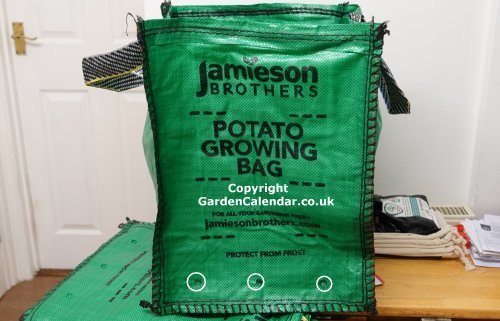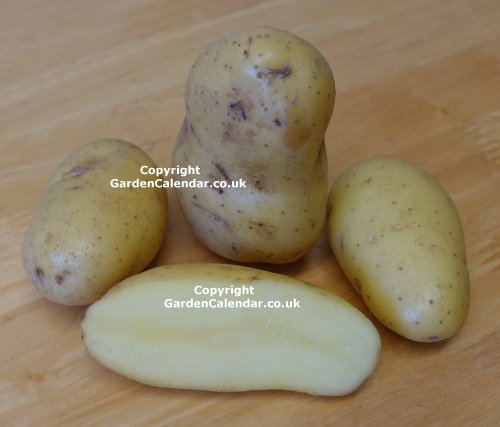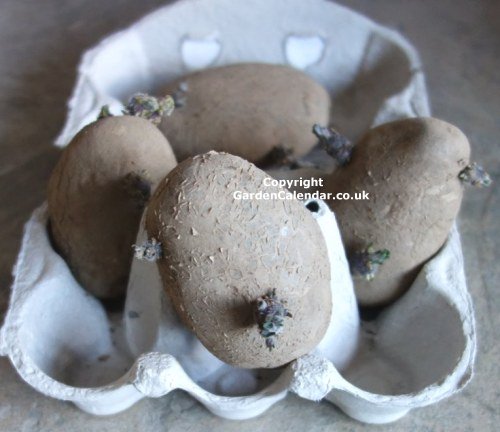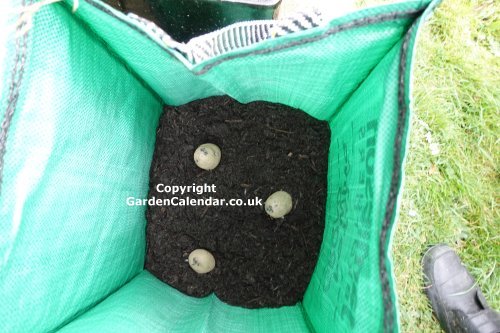There are several reasons why you might want to grow potatoes in containers. The obvious one is lack of space in your garden.
Other advantages include the ability to move the containers in the early stages (possibly to avoid frost or place in full sun), increased ability to protect from frost and ease of watering to obtain the correct moisture level in the soil.
An average sized container for growing potatoes is roughly 45cm (18in) tall by 30cm (12in) square. This size of container will need 40 to 50 litres of general purpose compost. It will be the correct size to grow three seed potatoes.
Do ensure that the potato growbag you choose has drainage holes in the base area of the bag. Without drainage, the seed potatoes are at risk of rotting. In the picture below, three drainage holes are highlighted by the three white circles and there are three more on the other side.
If you want to grow more seed potatoes than suggested the three above, I would strongly suggest that you use multiple bags rather than a larger bag. The larger the bag, the more difficult it is to move and the more difficult it is to keep the compost to the correct moisture content.

![]()
Well Constructed Potato Growbag
A good quality container (if stored correctly in winter and early spring) will last three or four years with no problems. The handles will also stay well attached for that time.
Many potato bags have a side flip cover at the base which is intended to make it easier to harvest the fully grown potatoes. It is however of little use, the best way to harvest potatoes in a container is from the top.
The side flip cover simply introduces a significant weakness into the potato bags, reducing their life for no practical purpose. Additionally, the potato growbags with side side flips cost far more compared to a standard potato growbag.
In theory, any variety of potato will grow in a container however some varieties grow far better than others. In general, maincrop potatoes are not well suited to container growing.
First Early varieties of potatoes are almost always suited to growing in containers. Two first early varieties we would highly recommend are Lady Christl and Swift. First Early varieties of potato grow quickly to maturity and have excellent taste. Their disadvantage is that they need to be eaten within a week or so of harvest, most do not store well.
Many Second Early varieties of potatoes also have excellent taste and they take slightly to reach maturity. The great advantage Second Early varieties have over First Early varieties is that they store far longer.

![]()
Jazzy, excellent for growing in containers.
Second Early varieties of potato which we would suggest as top class for container growing are Jazzy, Vitabella and Kestrel.
Potatoes grow well in good quality peat free general purpose compost. A few general purpose composts are still sold (as at 2025) containing peat but as far as potatoes are concerned peat free is just as good and in many cases better.
Our recommendations for a peat free compost for container growing potatoes are SylvaGrow with added John Innes, Morland Gold Multipurpose Compost or Pete's Peat-Free Multipurpose. Do not use garden soil, it may contain pests and / or diseases and will not be of the correct consistency for container growing.
Not surprisingly there are many similarities between growing potatoes in open ground and in containers.
The first step (for first and second early varieties only) is to chit / sprout the seed potatoes indoors. Maincrop varieties do not need chitting. This chitting / sprouting process is exactly the same whichever method of cultivation is used and full details can be found (the when, where and how) on our page 'Chit / Sprout Potatoes' here.
Start the chitting / sprouting process around first week of March in average areas of the UK. which takes four to five weeks. At which point in the sprouted seed potatoes will be ready to plant outside in the container(s).

![]()
Fully chitted / sprouted seed potatoes
The best position for the potato container(s) is one in full sun and in a protected position, as far as is possible, out of strong winds.
To plant the sprouted seed potatoes fill the base of each container with general purpose compost to a depth of 15cm / 6in. Place two to three sprouted seed potatoes equally apart in the compost with the majority of the sprouts (or all if possible) pointing upwards. Settle the seed potatoes gently 5cm / 2in into the top of the compost.

![]()
Seed potatoes planted in container
Add more compost over the seed potatoes so that they are covered by 8cm / 4in or so of compost. The compost should be slightly moist but definitely not wet. If it is dry, apply a little water.
You have now planted your container grown seed potatoes.
After 15 days or so (depends on temperature and variety) the potato foliage will appear above the compost level. When it reaches about 15cm / 6in above the compost surface gently add more compost to the container so that it nearly covers the foliage but with 8cm / 3in or so just poking through.
When the plants are primarily growing foliage (soon after the foliage starts to emerge), apply a nitrogen rich fertiliser such as Growmore twice at two week intervals. After six weeks, when the plants are putting more effort into growing the potato tubers, feed at two intervals using a potash base fertiliser such as Tomorite or similar tomato feed.
Check how moist the compost is again - it should be slightly moist but not wet. Add a little water if needed.
From then on until the potato plants have reached the height of the container, keep adding compost each time the foliage reaches about 15cm / 6in above the compost surface. The purpose of this is to ensure that, as the potato tubers form, they are always covered by compost. If potato tubers are exposed to light they quickly turn green and will then be inedible.
During the growing process described above it is possible that there is a later than average frost - keep an eye on the weather forecast for your area. If a late frost is predicted add more compost to the container so that all the foliage is just covered. Without fail the foliage will easily grow through that top layer of compost - potato plants are very strong growing plants.
From then on, until the potatoes are ready for harvest, the plants have only two requirements, feeding and watering.
As far as watering is concerned, the plants will need increasingly more water as the amount of foliage increases. The amount of water needed is heavily dependent on the weather conditions. In warm weather when the foliage is at its maximum size the plants may well need watering every day. If not watered well, you will soon notice that the foliage starts to droop.
Continue to feed the potato plants as described in the "CARE" section above.
As a rough guide, First Early varieties of potatoes will be ready for harvest 80 days after they are planted in the container (NOT when chitting / sprouting began), about the fourth week of June in average areas of the UK. Second Early varieties will be ready 100 days after they are planted (the second week of July in average areas of the UK) and Maincrop varieties will be ready 130 days after they are planted (the fourth week of August in average areas of the UK.
Using the above paragraph as a guide, confirmation that the potatoes are ready for harvest is an easy process. Gently burrow down with your hand into the compost and remove one potato. If it looks about the correct size, the potatoes are ready for harvest. If too small, give them another week or so and try again.
First Early potatoes generally should be harvested as soon as they are ready and consumed within approximately 10 days. First Early potatoes do not store well at all.
For Second Early potatoes, perform the same process. But many varieties of Second Early can remain in the soil for several weeks after their "best" harvest date. The varieties we recommend above for growing in containers, Jazzy, Vitabella and Kestrel, can all remain in the soil for a month or two past their "best" harvest date, some of them for several months.
When harvested, container grown potatoes can be treated exactly the same as potatoes grown in normal ground. See our article on storing potatoes for more details.
IF YOU HAVE ANY QUESTIONS OR COMMENTS
CONCERNING THIS PAGE, ENTER THEM BELOW.
WE WILL ANSWER ON
THIS PAGE AS SOON AS POSSIBLE